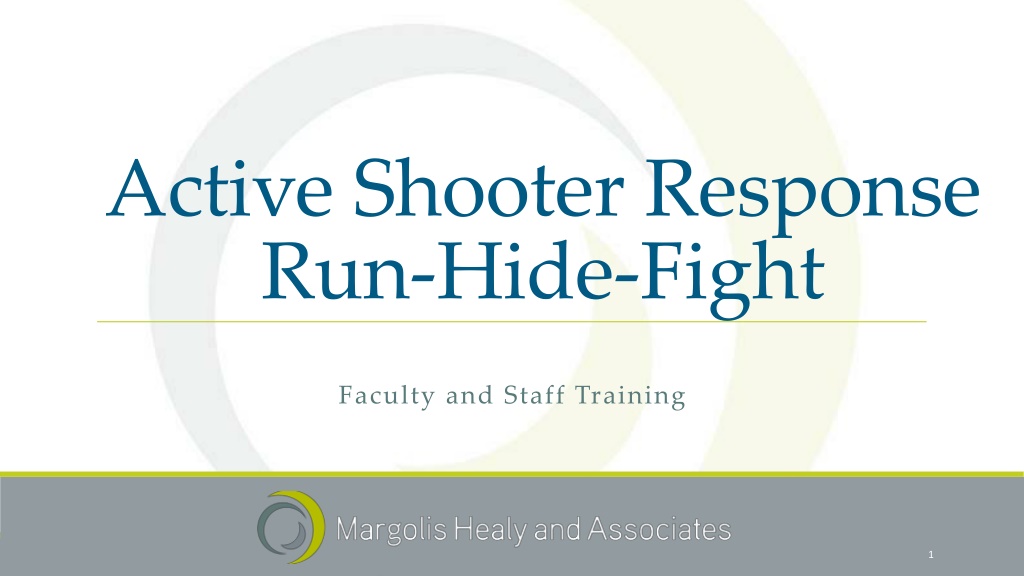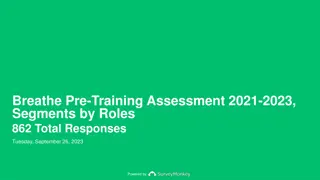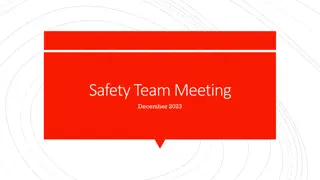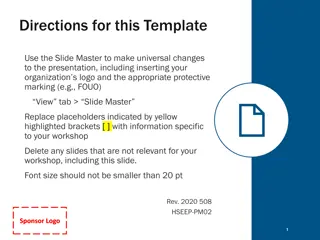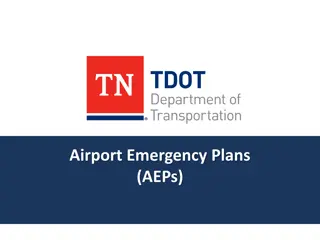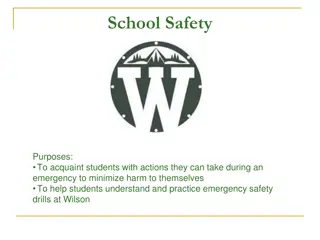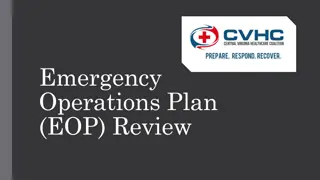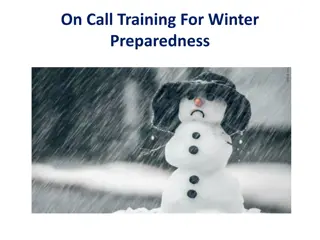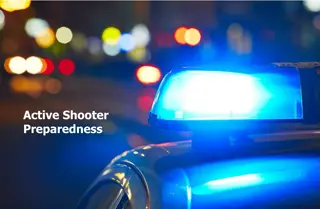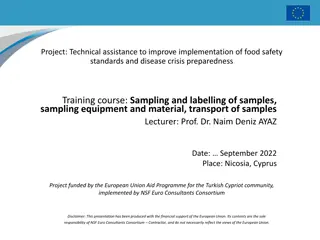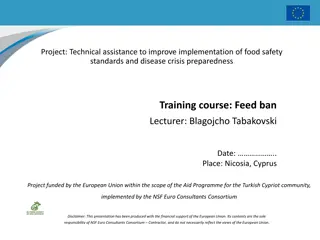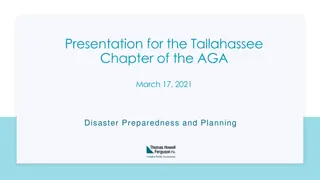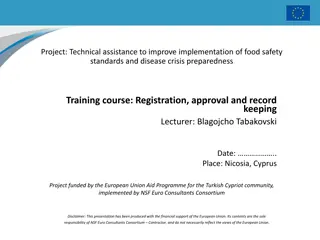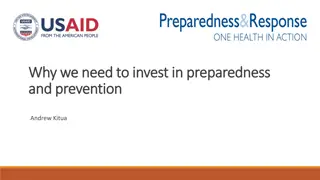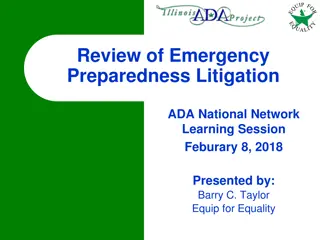School Safety Training and Preparedness Overview
Discuss the importance of response options to violent intruders, review past methodologies for change, identify personal responsibilities, review law enforcement actions, and evaluate the impacts of training on school communities. Emphasize self-care and address the evolving school safety landscape, active threat situations, and critical moments in school violence incidents.
Download Presentation

Please find below an Image/Link to download the presentation.
The content on the website is provided AS IS for your information and personal use only. It may not be sold, licensed, or shared on other websites without obtaining consent from the author. Download presentation by click this link. If you encounter any issues during the download, it is possible that the publisher has removed the file from their server.
E N D
Presentation Transcript
Active Shooter Response Run-Hide-Fight Faculty and Staff Training 1
Goals 1. Discuss importance of options based response to a violent intruder 2. Review past response methodologies and the need for change 3. Identify personal responsibilities and situational awareness 4. Review law enforcement actions upon their arrival 5. Impacts of this type of training on our school communities 2
Take Care of Yourself These are critical issues to discuss as school professionals It is understood that the topic could and will make some of us uncomfortable If you are having a strong response, please pay attention to it and take care of your emotional needs 3
The Evolving School Safety Landscape PREPAREDNESS PREVENTION MITIGATION Security Cameras School Violence Access Control & Visitor Management Cyber Threats Continuous Improvement School Security Program Resiliency Alarm Monitoring Education Awareness & Training Safety Surveys Criminal Mischief Severe Weather Emergency Communication Lighting RECOVERY RESPONSE Policy & Standards Way- Finding 4
What is an Active Threat? An Active Threat is defined as a violent situation in which a person(s) is, or appears ready to be, actively engaged in killing or attempting to kill others on school property. In most cases, this active threat involves an active threat using a firearm(s) and displaying no pattern or method for selection of victims. In some cases, active threats involve other weapons and /or improvised explosive devices intended to cause harm to victims or to impede police and emergency responders. These devices may detonate immediately, have a delayed detonation fuse, or may detonate on contact. 6
School Violence: What we know Active threat situations involving a shooter are highly fluid, as incidents evolve quickly and are unpredictable The active threat continues until stopped by law enforcement, suicide, or other intervention Often the active threat situation is over BEFORE law enforcement or first responders arrive on the scene THE MOMENTS BETWEEN WHEN AN ACTIVE THREAT BEGINS AND WHEN HELP ARRIVES ONSITE ARE CRITICAL AND OUR RESPONSE CAN SAVE LIVES 7
Traditional Law Enforcement Response to a Violent Intruder 8
Where are we headed? Options-Based Response to Violent Intruders No one-size response action fits every situation Individual life-saving options The importance of situational awareness 9
The importance of SITUATIONAL AWARENESS How will I know what to do in any emergency? 10
Why enhance the traditional Lockdown? Past incidents taught us that we needed to have other options available These situations are over in 3-8 minutes requiring immediate action What may be happening in one part of the building, may not be happening in another Same crisis MAY require different responses 11
Key Elements of Options-Based Response All adults in the building are empowered to use information at their disposal to make the most appropriate decision about their actions Provides each adult with options depending on the nature of the threat Distributes responsibility for personal safety and decision making Allows for faster notification to all staff of a potential active threat 12
Why do we do this? Trained Mind Anxious Recall what they ve learned Preparing to act as rehearsed Takes decisive action Untrained Mind Panic Disbelief & Denial Shock Freezes/Hesitates 13
Thank you for flying with Fire Drill Airline Flight Turn off lights Fasten seatbelt Close windows Oxygen mask Close doors Life vest Walk single file Identify exits (One nearest may be behind you!) Be silent Aisle path lighting Meet at warehouse, etc. 14
Run, Hide, Fight Similar to Hide Out, Get Out, Take Out Concept is to: Run if you can safely escape the area of the threat, you must make a decision based on the best information available Hide find a safe location to hide and avoid detection and potentially reinforce or harden your location Fight when faced with no other option, you may need to confront an active threat with the resolve that you will survive the encounter 15
What is RUN-HIDE-FIGHT? RUN, HIDE, FIGHT is the US Department of Homeland Security s recommended emergency response protocol. Does NOT replace current safety protocols or regular drills already in place such as LOCKDOWN or EVACUATION. DOES give additional tools that may be used to respond in an ACTIVE THREAT SITUATION. 16
Run Can be faculty or student initiated Have an escape route and plan that includes identified assembly areas located a safe distance away from the incident (Accountability) Leave personal belongings behind Ensure those with mobility challenges or other disabilities are cared for Must be prepared to change evacuation/run routes based on situational awareness Be prepared to transition to a lockdown /hide or fight option based or situational awareness Keep your hands visible 17
Hide and Reinforce Takes steps to barricade, reinforce or fortify your location Hide in an area out of the perpetrator s view Lock doors and use items such as desks, chairs, bookshelves to barricade the door Silence cell phones Ensure these areas are identified through training 18
Fight Last option for survival Taking back control of the situation Must assess individual capabilities Enhance survivability by utilizing available resources (fire extinguisher, books, heavy objects) to defend or protect yourself and incapacitate the perpetrator Consider developing a plan with others in your location to determine the best options for your survival (Swarming, distraction) 19
Turn and Talk What are the most important factors that come into play in making the decision to Run, Hide or Fight? What should you do if you don t know where the threat is? What can I do to ensure I am taking care of myself and others during this type of response? 20
Police Response to an Incident The police mission is to stop the suspect as soon as possible. They will proceed directly to the area where the last shots were heard The first officer on the scene will respond to the threat Officers may wear regular patrol uniforms or external bulletproof vests, Kevlar helmets and other tactical equipment Officers may shout commands, and may push individuals to the ground for their safety 21
Next Steps Review the ACTIVE THREAT PROCEDURE FOR YOUR SCHOOL Re-examine your teaching spaces and evacuation routes thinking about three possible responses: RUN HIDE FIGHT Ensure processes are in place to notify the entire school community of this type of threat. Staff responsible for making these notifications should practice using the schools emergency notification systems. 22
Post Tragedy Response Provide strategies for your school to enhance readiness, response, and recovery to help the school community in the event of a tragedy Be prepared before a crisis happens The immediate response influences long-term recovery Provide adequate, appropriate and sustainable mental health supports your school and community resources Be prepared to address a variety of reactions over the long-term Seek to find a new normal things may not be the same following an event. 23
Turn and Talk Discuss any challenges you have with what you have learned. Discuss if you feel more empowered to make individual life saving decisions? If not, why not? Can you identify any future training needs to ensure your school is better prepared to respond to a violent intruder. 24
Takeaways What are your best exit options for your classroom or teaching space? (Remember to think about more than just one exit route in case your main pathway to exit is blocked or unsafe to use.) How would you reinforce your classroom, teaching space or office if you were in a situation that would lead you to opt for the Hide action? Think about what items in your classroom or teaching space are readily available if you are in a situation that leads you to the Fight option. Review the (15 minute) Run Hide Fight training video contained in the Resources section of the presentation. 25
Resources and Connections Vermont Agency of Education and DPS Twitter Feed https://twitter.com/vted_safeschool Vermont School Safety Web Site: https://schoolsafety.vermont.gov/ Rob Evans: Director of K12 Services and Vermont School Safety Liaison revans@margolishealy.com Sunni Eriksen, Vermont Emergency Management sunni.Eriksen@Vermont.gov 27
